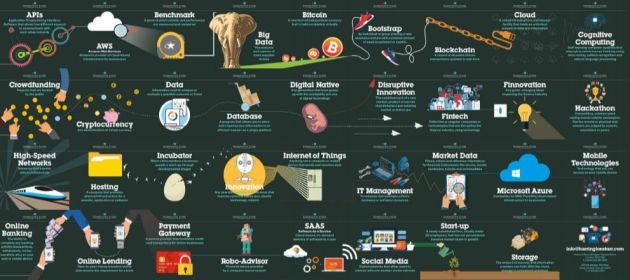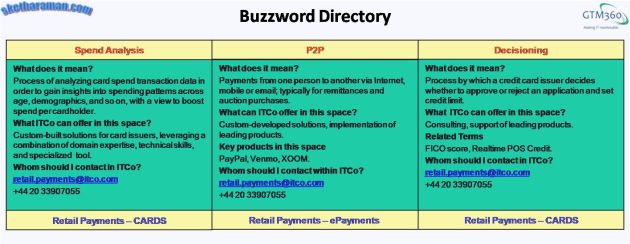jargon
/ˈdʒɑːɡ(ə)n
noun
special words or expressions used by a profession or group that are difficult for others to understand.
Many people go by the above dictionary meaning of the term jargon and rant against it.
They forget that jargon is also an abbreviation. Click here to see examples of jargon from various fields.
This is like a non-geek's pet peeve with a geek: "I understand HTML. Explain your HTML code without making any reference to CSS, JS. If you can't do that, you don't know HTML". https://t.co/UUtGJJdDWi
— S.Ketharaman (@s_ketharaman) December 17, 2018
In that avatar, jargon can be used very effectively in sales, marketing and business development.
In this blog post, I’ll share six secrets of doing that.
#1. SHARPEN MARKETING COLLATERAL
Jargon can be used to express concepts pithily in marketing collateral.
Without jargon, it becomes too verbose to express many concepts.
Take MDR for example. A jargon in the payments industry, MDR stands for “Merchant Discount Rate” and refers to the “fees incurred by merchant to process credit card payments”.
Somebody once pointed out that, if you strip away jargon, a standard six page credit card agreement would run into 24 pages.
#2. IMPROVE COLD CALL RESPONSE RATES
Sales Development Reps get very little time to make headway with prospects during a cold call. They often need to convey the crux of their message within the first 5-10 seconds of the call.
The pithy nature of jargon helps here. By using jargon, SDRs can convey a point in a fraction of the time that it would take to explain the full concept (i.e. without using jargon).
If you don’t believe this, ask your SDRs to do a mock call with you by using the following two variants of call opener, one with jargon and the other, without jargon.
With jargon: Our software helps you double your inventory turns.
Without jargon: Our software helps you double your company’s ratio of sales to inventory during a given period.
Even if you can tolerate listening to the full script once or twice, imagine how belabored your SDRs would sound to your prospects if they need to say it several times a call and hundreds of times a day!
#3. DEMONSTRATE DOMAIN KNOWLEDGE
Jargon helps your presales team demonstrate domain knowledge and establish authority in a certain field.
As Martin Weigel says in Strategy needs good words, “Judicious use of language that your client organisation uses can signal empathy and understanding. There’s nothing like jargon to signal membership of a community.”
As veteran sales leaders know, this is a key driver of success in big ticket size deals.
Your team can keep claiming that they have domain knowledge but prospects won’t believe their claim unless they hear the lingo of the domain.
To continue with the above example of MDR, your presales people won’t get far by saying “fees incurred by merchant to process credit card payments”.
Very soon, they would need to start using the MDR jargon in order to keep the prospect engaged.
Companies & people both pay a lot of money to find ways to sound more competent than the other guy and accordingly differentiate themselves from the crowd. If jargon is a cheap way of doing that, what's wrong in using it @fdestin ? pic.twitter.com/vnhouHeI5p
— S.Ketharaman (@s_ketharaman) December 19, 2018
#4. KILL “NO DECISIONS”
In the aforementioned rant, the original poster advocates vendors to eschew jargon and explain how their technology solves the customer’s pain areas in layman terms aka laymanize.
There are two problems with that approach.
One, buyers of B2B technology products and services are not laymen.
Two, it’s not as though every company with a certain pain point is eager to hear from every vendor who offers a solution for that pain point.
Pain alleviation goes thru’ various stages, starting from denial and recognition through to acceptance and resolution.
In virtually every company, the progression of pain alleviation through these stages is derailed by vested interests that benefit from maintaining the status quo. Result is, many companies don’t take any action to alleviate their pain. This explains why “no decision” is a frequent outcome in B2B technology deals.
Jargon helps work around these vested interests by jerking fencesitters out of their apathy and compelling them to assess the potential of the new technology to solve their pain. Without jargon, fencesitters would have continued to sit on the fence and vested interests would have scuttled new initiatives.
One more benefit of hype: It spurs laggard, fencesitter & dormant companies into action – via @mims @WSJ https://t.co/NB9ivu9FrN (Paywall Alert) pic.twitter.com/IeU8PClUgY
— GTM360 (@GTM360) April 11, 2018
While on this subject, let me hasten to add that jargon is not the only way to surface pain areas. My blog post entitled 3 Secrets To Uncovering Business Pain Areas describes a few more ways of doing so.
#5. APPEAR ON C-SUITE RADAR
If #4 fails, you need to involve the prospect’s top management to overcome operational-level apathy to new initiatives.
Jargon is a great way of doing so.
Many C-Level Executives attend conferences where hot new jargons are bandied about. If you tag your product or service to one or more of those hot new jargons, you have a good chance of appearing on their radar.
If CxOs are sufficiently impressed by what they hear about your company, they will push your product down to people at their operational level. When this happens, the pen pushers will have to take action. As any seasoned sales guy would know, this is one of the best ways to kill apathy and accelerate the sales cycle.
Stages of bringing new technology to market:
1. "Oh hell no."
2. "Politely, no, that technology would never work here."
4. "Neat, but not a priority for us."
5. "Maybe!"
6. "Actually nope, no budget."
7. "Well this is compelling."
8. "Where were you years ago?"— Aaron 📦 (@levie) October 3, 2018
#6. SPOT LATENT OPPORTUNITIES
Buzzwords fly around left, right and center during meetings, roadshows, and user conferences. Many of them signal unstated requirements for new products and services.
If the sales rep is clued in to them, she can spot opportunities that are not articulated explicitly. If not, she will lose those latent opportunities to a jargon-savvy competitor.
To help your field and inside sales teams to latch on to buzzwords and convert them into opportunities, you might want to compile and circulate a list of jargon in your space. For reference, I’m giving below an extract from a Buzzword Directory we developed for a technology solutions company in the payments technology space.
There are many good reasons why jargon has stood the test of time. It’s not going away anytime soon.
Don’t shy away from jargon. It’s a great weapon in the sales, marketing and business development armor.
Use jargon when the context permits and demands. You will see an uplift in your sales if you use jargon right.
"Laymanise: Transform technical jargon into simple, or layman's terms."
When you need jargon to express how to get rid of jargon, you know jargon is indispensable. pic.twitter.com/OITaKGp29L
— S.Ketharaman (@s_ketharaman) February 13, 2019
But, like all good things in life, too much jargon can become counterproductive.
Never use jargon to obscure the truth or as a substitute for independent, critical thinking.
Also nothing in this post should be construed as an endorsement of “Energy Supplementation Experience” (aka ‘Breakfast’) and other silly jargons listed in Fighting nonsense marketing jargon with nonsense marketing jargon!

